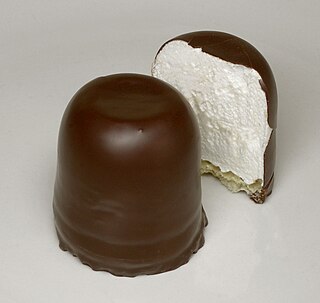
A cookie or biscuit is a baked snack or dessert that is typically small, flat, and sweet. It usually contains flour, sugar, egg, and some type of oil, fat, or butter. It may include other ingredients such as raisins, oats, chocolate chips, or nuts.

Dessert is a course that concludes a meal. The course consists of sweet foods, such as cake, biscuit, ice cream and possibly a beverage such as dessert wine and liqueur. Some cultures sweeten foods that are more commonly savory to create desserts. In some parts of the world there is no tradition of a dessert course to conclude a meal.

Confectionery is the art of making confections, which are food items that are rich in sugar and carbohydrates. Exact definitions are difficult. In general, however, confectionery is divided into two broad and somewhat overlapping categories: bakers' confections and sugar confections. The occupation of confectioner encompasses the categories of cooking performed by both the French patissier and the confiseur.

A chocolate bar is a confection containing chocolate, which may also contain layerings or mixtures that include nuts, fruit, caramel, nougat, and wafers. A flat, easily breakable, chocolate bar is also called a tablet. In some varieties of English and food labeling standards, the term chocolate bar is reserved for bars of solid chocolate, with candy bar used for products with additional ingredients.

Chocolate-coated marshmallow treats, also known as chocolate teacakes, are confections consisting of a biscuit base topped with marshmallow-like filling and then coated in a hard shell of chocolate. They were invented in Denmark in the 19th century and later also produced and distributed by Viau in Montreal as early as 1901. Numerous varieties exist, with regional variations in recipes. Some variants of these confections have previously been known in many countries by names comprising equivalents of the English word negro.

Oreo is a brand of sandwich cookie consisting of two cocoa biscuits or cookie pieces with a sweet fondant filling. It was introduced by Nabisco on March 6, 1912, and through a series of corporate acquisitions, mergers, and splits, both Nabisco and the Oreo brand have been owned by Mondelez International since 2012. Oreo cookies are available in over one hundred countries. Many varieties of Oreo cookies have been produced, and limited-edition runs have become popular in the 21st century.

Pocky is a Japanese sweet snack food produced by the Ezaki Glico food company. Pocky was first sold in 1966, and was invented by Yoshiaki Koma. It consists of coated biscuit sticks. It was named after the Japanese onomatopoeic word pokkiri (ポッキリ), which is supposed to resemble the sound of the snack being cracked.

Marzipan is a confection consisting primarily of sugar and almond meal, sometimes augmented with almond oil or extract.

A wafer is a crisp, often sweet, very thin, flat, light biscuit, often used to decorate ice cream, and also used as a garnish on some sweet dishes. They frequently have a waffle surface pattern but may also be patterned with insignia of the food's manufacturer or may be patternless. Some chocolate bars, such as Kit Kat and Coffee Crisp, are wafers with chocolate in and around them.

Jaffa Cakes are a cake introduced by McVitie and Price in the UK in 1927 and named after Jaffa oranges. The most common form of Jaffa cakes are circular, 2+1⁄8 inches (54 mm) in diameter and have three layers: a Genoise sponge base, a layer of orange flavoured jam and a coating of chocolate. Each cake is 46 calories. Jaffa Cakes are also available as bars or in small packs, and in larger and smaller sizes. The original Jaffa Cakes now come in packs of 10, 20, 30, or 40, having been downsized in 2017 from 12 or 24 per pack.

Compound chocolate is a product made from a combination of cocoa, vegetable fat and sweeteners. It is used as a lower-cost alternative to pure chocolate, as it uses less-expensive hard vegetable fats such as coconut oil or palm kernel oil in place of the more expensive cocoa butter. It may also be known as "compound coating" or "chocolatey coating" when used as a coating for candy. It is often used in less expensive chocolate bars to replace enrobed chocolate on a product.

An icebox cake is a dairy-based dessert made with cream, fruits, nuts, and wafers and set in the refrigerator. One particularly well-known version used to be printed on the back of boxes of thin and dark Nabisco Famous Chocolate Wafers.

Chocolate is a food product made from roasted and ground cocoa pods mixed with fat and powdered sugar to produce a solid confectionery. There are several types of chocolate, classified primarily according to the proportion of cocoa and fat content used in a particular formulation.
Flipz is a type of confectionery created by Nestlé in 1997, consisting of salted pretzels covered in chocolate and other coatings.
The following outline is provided as an overview of and topical guide to chocolate:

An enrober is a machine used in the confectionery industry to coat a food item with a coating medium, typically chocolate. Foods that are coated by enrobers include nuts, ice cream, toffee, chocolate bars, biscuits and cookies. Enrobing with chocolate extends a confection's shelf life.

A sandwich cookie, also known as a sandwich biscuit, is a type of cookie made from two thin cookies or medium cookies with a filling between them. Many types of fillings are used, such as cream, ganache, buttercream, chocolate, cream cheese, jam, peanut butter, lemon curd, or ice cream.















